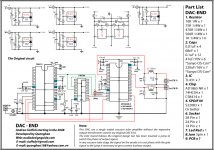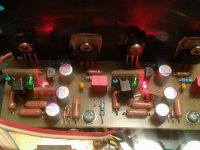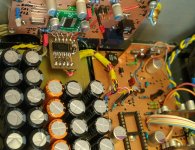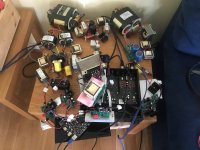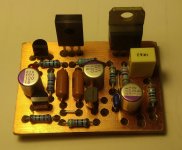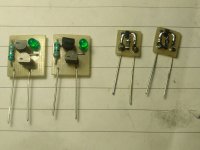Hi, I'm building a dac with AD1865 (a clone of the note audio), with the cs8414 receiver, both chips have both analog and digital power, and I was wondering: how useful would it be to separate the power supplies of the two chips? Making an analog and digital power supply for the dac, and one also for the receiver, so as to have a total of 4 power supplies, 2 each chip. All power supplies are further filtered with the tl431. Like this scheme.
Tiziano
Tiziano
Attachments
In my DAC (DIR9001-PMD100-PCM1702) I have five separate power supplies (five secondary windings), one with three ADP7181 for DIR9001 and digital selector, two separate with ADM7150 and Walt Jung shunt regulator for PMD100 and one double for +/- 5V for PCM1702, the regulators are also Walt Jung shunt.
It is certainly better to separate as much as possible, especially analog from digital sections.
I recommend the Walt Jung shunt regulator to power digital circuits, especially the dac ICs .
It is certainly better to separate as much as possible, especially analog from digital sections.
I recommend the Walt Jung shunt regulator to power digital circuits, especially the dac ICs .
Attachments
I agree wholeheartedly with grunf above. It surprises me that no-one has yet measured (or been able to measure) the obvious sonic improvement brought about by separating supplies even though this is commonplace in high quality commercial equipment. I recently bought a Soncoz SGD1 and have separated out each of its supply feeds resulting in the best DAC I have ever heard.
I would recommend the Jung super regs, both shunt and series versions. The series version is available from the DIYaudio store. These offer lower noise, lower output impedance and better line rejection than other regulators that I have tried. I would also recommend a separate transformer winding for each and an upstream cap multiplier for each regulator. The only down side is then the need for higher voltage transformers and more space.
If you are able make the changes incrementally, listening at length after each you will be convinced of the benefits. I find this very rewarding. Suggest you start with just one well built super-reg feeding both loads and then double up on the regs and separate the loads.
Be warned though, you could end up with something like this...
I would recommend the Jung super regs, both shunt and series versions. The series version is available from the DIYaudio store. These offer lower noise, lower output impedance and better line rejection than other regulators that I have tried. I would also recommend a separate transformer winding for each and an upstream cap multiplier for each regulator. The only down side is then the need for higher voltage transformers and more space.
If you are able make the changes incrementally, listening at length after each you will be convinced of the benefits. I find this very rewarding. Suggest you start with just one well built super-reg feeding both loads and then double up on the regs and separate the loads.
Be warned though, you could end up with something like this...
Attachments
Yeah I know the article, but aside of the measurements I wanted to know actual listening test results.
Of course there is no definite opinion about this, different DACs, different setups could have different results. If we narrow it down to R2R dacs, (1865, 1704, 1541) what's your findings, especially regarding powering the DAC chip (its analog and digital side)?
Of course there is no definite opinion about this, different DACs, different setups could have different results. If we narrow it down to R2R dacs, (1865, 1704, 1541) what's your findings, especially regarding powering the DAC chip (its analog and digital side)?
I use low noise LDOs for the digital stuff (and clocks), and use better sounding voltage regulators for the analog audio frequency stuff (including DAC AVCC/Vref). A trick that can help with LDOs is to load them with a resistor to ground so the LDO is operating at mid to high-ish current. For a 3.3v digital or clock rail, a resistor that draws an extra 100mA or maybe a bit less sometimes has audible benefits that can be heard at the analog output of a dac. Just have to try it and see if any benefit for a particular circuit.
Moving along to the analog side, LT1083 can work surprisingly well for some things such as opamp rails. Ones like this are pretty good: LT1083 High Power Adjustable HIFI Linear Dual Output Power Supply Board | eBay ...If the above board is used with transformers having separate windings (not center-tapped) then one LT1083 can be used "upside down" as the negative 15v regulator.
Also, R-core transformers are very good for minimizing AC line noise from getting into sensitive audio circuitry, so I prefer them most of the time.
Moving along to the analog side, LT1083 can work surprisingly well for some things such as opamp rails. Ones like this are pretty good: LT1083 High Power Adjustable HIFI Linear Dual Output Power Supply Board | eBay ...If the above board is used with transformers having separate windings (not center-tapped) then one LT1083 can be used "upside down" as the negative 15v regulator.
Also, R-core transformers are very good for minimizing AC line noise from getting into sensitive audio circuitry, so I prefer them most of the time.
Last edited:
If we narrow it down to R2R dacs, (1865, 1704, 1541) what's your findings, especially regarding powering the DAC chip (its analog and digital side)?
In my little experience, the power supplies that really left their mark on me are: the first ever that of the legendary sony DAS-R1, which is the dac of the legendary CDP-R1, very complex and expensive power supply, I had mounted it on breadbord and it sounded great, I don't know if I will ever try to build a pcb because it is very complex, this has 2 power supplies, one digital side and one analog side, the second is the copy of the studer 900 phantom power supply, this one for the part analogue for me has no rivals, a little below the legendary sony but of excellent level, using it as a digital I did not find any differences with the salas shunt.
Yeah I know the article, but aside of the measurements I wanted to know actual listening test results.
Of course there is no definite opinion about this, different DACs, different setups could have different results. If we narrow it down to R2R dacs, (1865, 1704, 1541) what's your findings, especially regarding powering the DAC chip (its analog and digital side)?
I have tested a lot of regulators in my DAC, Salas shunt, ADM7150, ADP7181, WJ serial and shunt and various other regulators.
Those that sounded the best attenuated the HF noise the most, which can also be seen on the oscilloscope.
It is important that the regulator is as close as possible to the ICs, that it has a CRCRC filter before the regulator itself and that each regulator has its own secondary on the transformer.
In my opinion, the winner is the Walt Jung shunt regulator which is not something popular on the forum, probably because there is no kit or PCB on sale.
The ADM7150 and ADP7181 are also good, especially the ADM7150 and can be used for input receiver and auxiliary circuits (clock, filter, ..) or possibly the DAC ICs themselves. Salas' shunt is OK, but it's not in the range of WJ shunt or, say, ADM7150. The WJ serial regulator is more for powering the analog section, I wasn’t happy with it when I tested it around digital.
For the DAC ICs itself the best is WJ shunt, especially the analog section, I now use them to power the PCM1702 and only to power the VDD1 filter for PMD100, to power the VDD2 output interface I use the ADM7150.
The PMD100 is otherwise great for testing regulators because it produces quite a lot of HF noise.
A WJ shunt can be made on a small PCB so it can be easily implemented in an existing device. By the way, I have been making WJ controllers for the last 15 years and I can say that they are the best audio regulators.
I plan to make two more DACs, one with SAA3750 + TDA1547 and the other with PCM1794, both are R2R and I will greatly use WJ shunt for regulators in them.
And not to forget the WJ shunt can still be improved, I'm just working on it and so far I have great results with 2.5V WJ LED references.
Pictured below is a WJ shunt I made for the PMD100 and a new 2.5V reference with jfet CCS for power reference.
Attachments
I could have PCBs produced if there was a good interest. I would be happy if you could help me in the PCB design too, what do you think?I have tested a lot of regulators in my DAC, Salas shunt, ADM7150, ADP7181, WJ serial and shunt and various other regulators.
Those that sounded the best attenuated the HF noise the most, which can also be seen on the oscilloscope.
It is important that the regulator is as close as possible to the ICs, that it has a CRCRC filter before the regulator itself and that each regulator has its own secondary on the transformer.
In my opinion, the winner is the Walt Jung shunt regulator which is not something popular on the forum, probably because there is no kit or PCB on sale.
The ADM7150 and ADP7181 are also good, especially the ADM7150 and can be used for input receiver and auxiliary circuits (clock, filter, ..) or possibly the DAC ICs themselves. Salas' shunt is OK, but it's not in the range of WJ shunt or, say, ADM7150. The WJ serial regulator is more for powering the analog section, I wasn’t happy with it when I tested it around digital.
For the DAC ICs itself the best is WJ shunt, especially the analog section, I now use them to power the PCM1702 and only to power the VDD1 filter for PMD100, to power the VDD2 output interface I use the ADM7150.
The PMD100 is otherwise great for testing regulators because it produces quite a lot of HF noise.
A WJ shunt can be made on a small PCB so it can be easily implemented in an existing device. By the way, I have been making WJ controllers for the last 15 years and I can say that they are the best audio regulators.
I plan to make two more DACs, one with SAA3750 + TDA1547 and the other with PCM1794, both are R2R and I will greatly use WJ shunt for regulators in them.
And not to forget the WJ shunt can still be improved, I'm just working on it and so far I have great results with 2.5V WJ LED references.
Pictured below is a WJ shunt I made for the PMD100 and a new 2.5V reference with jfet CCS for power reference.
- Home
- Source & Line
- Digital Source
- Question about the separate power supply of the AD1865
